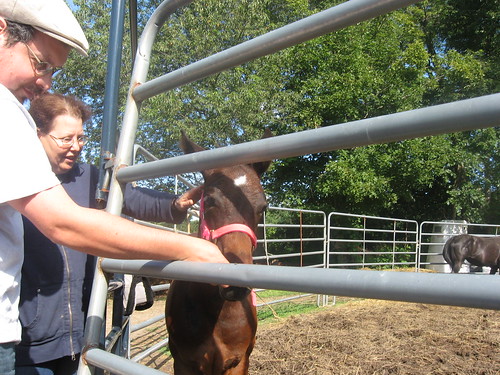|
|
Wednesday, July 14th, 2010
I've started reading Richard Slotkin's Regeneration through violence with the idea that I might be able to draw some parallels between his narrative of myth formation and Borges' stories... In service of that end, here is a passage from "Narrative of the Warrior and the Captive Maiden" (from The Aleph) and one from Slotkin's book.
John Williams' narrative, The Redeemed Captive, taught that the ultimate salvation of the soul itself was really at stake in the trial by captivity. One of Williams' daughters, who was very young when captured, could not be won from her captors in time for repatriation with her father. The result was typical of the fate of many captives: she forgot her language and her catechism and became at once a papist and a pagan savage, married to an Indian. Despite the efforts of her father and her family to bring her back, she refused all opportunities to resume her former life. On one occasion she returned to the neighborhood of her birthplace (Deerfield, MA) dressed as an Indian. Her friends clothed her in the English fashion and sent her to meeting, but she "indignantly threw off her clothes in the afternoon, and resumed the Indian blanket." By her own declaration she preferred the Indian way of life. ...she declared that she would never move again from Canada to New England because to do so would "endanger her soul."
Her visit occurred in 1740-41 at the height of the Great Awakening, and her presence in the congregation had been the occasion for "A Sermon Preached at Mansfield, August 4, 1741, at a Time set apart for Prayer for the Revival of Religion," by Pastor Solomon Williams. It was perhaps Williams' attempt to use her as an example of God's delivering a soul from bondage to the devil that made her afraid of "losing" in New England the "soul" she had developed in thirty-eight years of captivity.
-- Chapter 4, "Israel in Babylon"
Perhaps for one instant the two women saw that they were sisters; they were far from their beloved island in an incredible land. My grandmother, enunciating carefully, asked some question or other; the other woman replied haltingly, searching for the words and then repeating them, as though astonished at the old taste of them. It must have been fifteen years since she'd spoken her native language, and it was not easy to recover it. She said she was from Yorkshire, that her parents had emigrated out to Buenos Aires, that she had lost them in an Indian raid, that she had been carried off by the Indians, and that now she was the wife of a minor chieftain -- she'd given him two sons; he was very brave. She said all this little by little, in a clumsy sort of English interlarded with words from the Auracan or Pampas tongue, and behind the tale one caught glimpses of a savage and uncouth life... An Englishwoman, reduced to such barbarism! Moved by outrage and pity, my grandmother urged her not to go back. She swore to help her, swore to rescue her children. The other woman answered that she was happy, and she returned that night to the desert.
--"The Warrior and the Captive Maiden" (Hurley's translation)
 Further reading -- The Redeemed Captive; Narrative of the Captivity of Mary Rowlandson
posted evening of July 14th, 2010: Respond
➳ More posts about Regeneration through violence
|  |
Saturday, February 5th, 2011
 Rereading "La escritura del dios" last week, I was inspired to do some searching for background material, to find out who is Qaholom, the god who has written his sacred scripture in the markings of the jaguar for Tzinacán to read. I found out about the Popol Vuh, a transcription of the K'iche' creation story -- written down in the 1500's by a Jesuit missionary in Quiché, Guatemala based on the reading of a (no longer extant) hieroglyphic document, translated into Spanish and annotated by Adrián Recinos. Rereading "La escritura del dios" last week, I was inspired to do some searching for background material, to find out who is Qaholom, the god who has written his sacred scripture in the markings of the jaguar for Tzinacán to read. I found out about the Popol Vuh, a transcription of the K'iche' creation story -- written down in the 1500's by a Jesuit missionary in Quiché, Guatemala based on the reading of a (no longer extant) hieroglyphic document, translated into Spanish and annotated by Adrián Recinos.
According to Recinos, Qaholom is "the paternal god, the god who sires children, from qahol, 'a father's son', qaholoj, 'engender'." Recinos also notes that Gucumatz (one third of the trinity which is called Heart of the Heavens, and I think possibly another name for Qaholom? -- I haven't quite got the pantheon straight yet) is a "serpent covered with green feathers, from from guc, in Maya, kuk, 'green feathers', Quetzal via antonomasia, and cumatz, 'serpent'; he is the K'iche' version of Kukulkán, the Mayan name for Quetzalcoatl, the Toltec king, conqueror, bringer of civilization, god in Yucatán during the epoch of the Post-classical Mayan Empire."
posted morning of February 5th, 2011: Respond
➳ More posts about Jorge Luis Borges
|  |
Saturday, June 27th, 2015
Not totally sure what to make of this yet... It is at the very least a fascinating idea for a project...

posted morning of June 27th, 2015: Respond
➳ More posts about Readings
| |
|
Drop me a line! or, sign my Guestbook.
•
Check out Ellen's writing at Patch.com.
| |








 Rereading
Rereading 



